历届奥运会奖牌设计一览(1956-2008)
Beijing 2008 Medal 北京奥运会奖牌
 The medals are 70mm in diameter and 6mm in thickness. On their obverse side, the medals adopt the standard design prescribed by the International Olympic Committee (IOC) -- a drawing that represents the winged goddess of victory Nike and Panathinaikos Arena, while on their reverse side, the medals are inlaid with jade with the Beijing Games emblem engraved in the metal centerpiece.
The medals are 70mm in diameter and 6mm in thickness. On their obverse side, the medals adopt the standard design prescribed by the International Olympic Committee (IOC) -- a drawing that represents the winged goddess of victory Nike and Panathinaikos Arena, while on their reverse side, the medals are inlaid with jade with the Beijing Games emblem engraved in the metal centerpiece.
北京2008年奥运会奖牌直径为70毫米,厚6毫米。奖牌正面为国际奥委会统一规定的图案——插上翅膀站立的希腊胜利女神和希腊潘纳辛纳科竞技场。奖牌背面镶嵌着取自中国古代龙纹玉璧造型的玉璧,背面正中的金属图形上镌刻着北京奥运会会徽。
Athens 2004 Medal 雅典奥运会奖牌
The main feature of the medals is the Greek character shown on both sides, since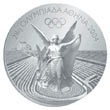 their basic side has been changed for the first time since the Amsterdam Olympic Games in 1928. This is of particular importance, as from now on all Olympic medals will reflect the Greek character of the Games as regards both their origin and their revival.
their basic side has been changed for the first time since the Amsterdam Olympic Games in 1928. This is of particular importance, as from now on all Olympic medals will reflect the Greek character of the Games as regards both their origin and their revival.
自1928年阿姆斯特丹奥运会以来,奖牌正面的设计首次修改,以反映希腊特色。从此以后,所有奥林匹克奖牌都将反映希腊特色,因为它是奥运会的起源和复兴之地。从1928年阿姆斯特丹奥运会到2000年悉尼奥运会,颁给运动员的奖牌上刻的都是胜利女神奈基的坐像。
Sydney 2000 Medal 悉尼奥运会奖牌
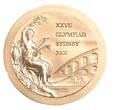 The customary symbols, including the Victory Goddess holding a winner's crown, are engraved on the obverse face. The Sydney Opera House, the Olympic torch and the Olympic rings are represented on the reverse. The designers are Australian: Woljciech Pietranik and Brian Thompson.
The customary symbols, including the Victory Goddess holding a winner's crown, are engraved on the obverse face. The Sydney Opera House, the Olympic torch and the Olympic rings are represented on the reverse. The designers are Australian: Woljciech Pietranik and Brian Thompson.
手握月桂花冠的胜利女神等传统标志刻在奖牌正面。悉尼歌剧院、奥林匹克火炬和奥林匹克五环刻在奖牌背面。奖牌的设计者是澳大利亚人沃利塞克-皮耶特兰尼克和布利安-汤姆森。
Atlanta 1996 Medal 亚特兰大奥运会奖牌
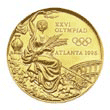 On the obverse, a drawing that has been in use since the Amsterdam Games of
On the obverse, a drawing that has been in use since the Amsterdam Games of  1928, representing Nike, the goddess of victory, holding palms in her left hand, and, in her right hand, held over her head, a winner's crown. On the reverse, the logo of the 1996 Games and a stylized olive branch.
1928, representing Nike, the goddess of victory, holding palms in her left hand, and, in her right hand, held over her head, a winner's crown. On the reverse, the logo of the 1996 Games and a stylized olive branch.
奖牌正面是自1928年阿姆斯特丹奥运会以来一直使用的胜利女神奈基的像。奈基的左手托着棕榈叶,右手举过头顶,托着胜利者的月桂花冠。奖牌背面是1996年奥运会标识和橄榄枝。
Barcelona 1992 Medal 巴塞罗那奥运会奖牌
On the obverse, a medallion 56mm in diameter, superimposed on the medal and  slightly off-centre, on which the image of the goddess of victory appeared, drawn in a Modernist style, together with the words "XXV Olimpíada Barcelona 1992". On the reverse the official emblem of the Barcelona Games.
slightly off-centre, on which the image of the goddess of victory appeared, drawn in a Modernist style, together with the words "XXV Olimpíada Barcelona 1992". On the reverse the official emblem of the Barcelona Games.
牌正面是一个直径55毫米的圆形图案,上面刻着带有现代风格的胜利女神奈基的形象,并刻有“1992年第25届巴塞罗那奥运会”字样。奖牌背面是巴塞罗那奥运会会徽。
Seoul 1988 Medal 汉城奥运会奖牌
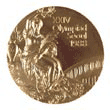 On the obverse, the ancient coliseum and the goddess of victory holding the laurel crowns and the caption: "XXIV Olympiad Seoul 1988". On the reverse, a dove, the symbol of peace, soaring up, holding a laurel branch in its mouth, and the Seoul Olympic sash composed of three Taeguk patterns from the Korean national flag and the five Olympic rings.
On the obverse, the ancient coliseum and the goddess of victory holding the laurel crowns and the caption: "XXIV Olympiad Seoul 1988". On the reverse, a dove, the symbol of peace, soaring up, holding a laurel branch in its mouth, and the Seoul Olympic sash composed of three Taeguk patterns from the Korean national flag and the five Olympic rings.
奖牌正面是古代竞技场和手持月桂花冠的胜利女神以及“第24届汉城奥运会”字样。奖牌背面是一只象征和平的鸽子,它在翱翔,嘴里衔着一根月桂树枝。
Los Angeles 1984 Medal 洛杉矶奥运会奖牌
The obverse of the medal features the ancient coliseum and the goddess of victory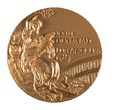 holding a winner's crown. The reverse of the medal features a victorious athlete, a palm branch carried by jubilant athletes, and a stadium in the background.
holding a winner's crown. The reverse of the medal features a victorious athlete, a palm branch carried by jubilant athletes, and a stadium in the background.
奖牌正面是古代竞技场和手持月桂花冠的胜利女神奈基。奖牌背面表现手持棕榈叶的一群欢乐的运动员将获胜运动员高高举起的情景,背景是体育场。
Moscow 1980 Medal 莫斯科奥运会奖牌
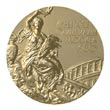 On the obverse, the traditional Olympic symbol of victory: the goddess Nike holding a laurel wreath; in the lower right-hand corner, a fragment of the colosseum, above it, the inscription in Cyrillic Igry XXII Olimpiady Moskva 1980. On the reverse, a stylised Olympic Bowl with a burning flame (not burning a burning flame) against the background of a stadium arena. The upper right-hand segment, carries the insignia of the Moscow Olympics.
On the obverse, the traditional Olympic symbol of victory: the goddess Nike holding a laurel wreath; in the lower right-hand corner, a fragment of the colosseum, above it, the inscription in Cyrillic Igry XXII Olimpiady Moskva 1980. On the reverse, a stylised Olympic Bowl with a burning flame (not burning a burning flame) against the background of a stadium arena. The upper right-hand segment, carries the insignia of the Moscow Olympics.
奖牌正面是表示胜利的传统奥林匹克标志:高举月桂花冠的胜利女神奈基。奖牌正面右下角是一座大型竞技场的片断,上方用西里尔文字写着“1980年第22届莫斯科奥运会”。奖牌背面表现的是,圣火在体育场背景的衬托下熊熊燃烧,右上角是莫斯科奥运会会徽。
Montreal 1976 Medal 蒙特利尔奥运会奖牌
On the obverse, the design of Guiseppe Cassioli, created for the Amsterdam Games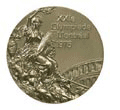 in 1928. The principal symbols are Victory, Fraternity and Universality. The reverse was designed as intentionally bare. It comprises a stylized laurel crown, symbol of victory since the Games of Antiquity, and the emblem of the Montreal Games.
in 1928. The principal symbols are Victory, Fraternity and Universality. The reverse was designed as intentionally bare. It comprises a stylized laurel crown, symbol of victory since the Games of Antiquity, and the emblem of the Montreal Games.
奖牌正面是意大利人朱塞比-卡西奥利(1865-1942)为1928年阿姆斯特丹奥运会设计的图案。主要标志的含义是胜利、博爱、普遍性。奖牌背面是一支月桂花冠,它是自古代奥运会以来胜利的象征。此外刻有蒙特利尔奥运会会徽。
Munich 1972 Medal 慕尼黑奥运会奖牌
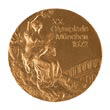 On the obverse, the traditional goddess of victory, a design used since the 1928 Amsterdam Games, accompanied by the specific inscription "XX Olympiade München 1972". On the reverse, Castor and Pollux, the twin sons of Zeus and Léda, the patrons of sports competitions and friendship, represented by two naked youths. This design was created by Gerhard Marcks, one of the last representatives of the Bauhaus.
On the obverse, the traditional goddess of victory, a design used since the 1928 Amsterdam Games, accompanied by the specific inscription "XX Olympiade München 1972". On the reverse, Castor and Pollux, the twin sons of Zeus and Léda, the patrons of sports competitions and friendship, represented by two naked youths. This design was created by Gerhard Marcks, one of the last representatives of the Bauhaus.
奖牌正面是自1928年阿姆斯特丹奥运会以来一直沿用的胜利女神,并刻有“1972年第20届慕尼黑奥运会”字样。奖牌背面是宙斯和勒达的孪生子,代表体育比赛和友谊的赞助者。奖牌的设计者是包豪斯建筑学派的最后代表人物之一、德国人格哈德-玛克斯。
Mexico 1968 Medal 墨西哥奥运会奖牌
On the obverse, the traditional goddess of victory, holding a palm in her left hand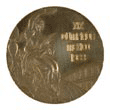 and a winner's crown in her right. A design used since the 1928 Games in Amsterdam, created by Florentine artist Giuseppe Cassioli (ITA -1865-1942) and chosen after a competition organised by the International Olympic Committee in 1921. On the reverse, an Olympic champion carried in triumph by the crowd, with the Olympic stadium in the background.
and a winner's crown in her right. A design used since the 1928 Games in Amsterdam, created by Florentine artist Giuseppe Cassioli (ITA -1865-1942) and chosen after a competition organised by the International Olympic Committee in 1921. On the reverse, an Olympic champion carried in triumph by the crowd, with the Olympic stadium in the background.
奖牌正面是传统的胜利女神像,她的左手拿着一束棕榈叶,右手举着月桂花冠。这是自1928年阿姆斯特丹奥运会以来一直沿用的设计,设计家是佛罗伦萨艺术家、意大利人朱塞比-卡西奥利(1865-1942),他的作品在国际奥委会于1921年举办的一次竞赛中脱颖而出。奖牌背面表现的是雀跃的人们举起一名奥运冠军的情景,背景是奥林匹克体育场。
Tokyo 1964 Medal 东京奥运会奖牌
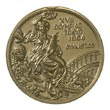 On the obverse, the traditional goddess of victory, holding a palm in her left hand and a winner's crown in her right. A design used since the 1928 Games in Amsterdam, created by Florentine artist Giuseppe Cassioli (ITA -1865-1942) and chosen after a competition organised by the International Olympic Committee in 1921. On the reverse, an Olympic champion carried in triumph by the crowd, with the Olympic stadium in the background.
On the obverse, the traditional goddess of victory, holding a palm in her left hand and a winner's crown in her right. A design used since the 1928 Games in Amsterdam, created by Florentine artist Giuseppe Cassioli (ITA -1865-1942) and chosen after a competition organised by the International Olympic Committee in 1921. On the reverse, an Olympic champion carried in triumph by the crowd, with the Olympic stadium in the background.
奖牌正面为传统的胜利女神。她左手持棕榈叶,右手拿着胜利者佩戴的花冠。本届奥运会的胜利女神图像由佛罗伦萨艺术家卡西奥里设计,并在国际奥委会组织的设计比赛中被选作奥运会奖牌正面图样沿用至今。奖牌正面右方刻有“东京1964--第18届奥运会”字样,背景为古罗马竞技场图案。奖牌背面为一名奥运冠军被群众簇拥,场面欢欣鼓舞。背景是奥林匹克体育场。
Rome 1960 Medal 罗马奥运会奖牌
On the obverse, the traditional goddess of victory, holding a palm in her left hand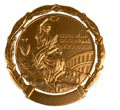 and a winner's crown in her right. A design used since the 1928 Games in Amsterdam, created by Florentine artist Giuseppe Cassioli (ITA -1865-1942) and chosen after a competition organised by the International Olympic Committee in 1921. On the reverse, an Olympic champion carried in triumph by the crowd, with the Olympic stadium in the background.
and a winner's crown in her right. A design used since the 1928 Games in Amsterdam, created by Florentine artist Giuseppe Cassioli (ITA -1865-1942) and chosen after a competition organised by the International Olympic Committee in 1921. On the reverse, an Olympic champion carried in triumph by the crowd, with the Olympic stadium in the background.
奖牌正面右方刻有“罗马1960--第17届奥运会”字样,背景为古罗马竞技场图案。奖牌背面为一名奥运冠军被群众簇拥,场面欢欣鼓舞。背景是奥林匹克体育场。
MELBOURNE 1956 Medal 墨尔本奥运会奖牌
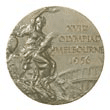 For these Games, the picture of victory is accompanied by the specific inscription: "XVIth OLYMPIAD MELBOURNE 1956". On the reverse, an Olympic champion carried in triumph by the crowd, with the Olympic stadium in the background.
For these Games, the picture of victory is accompanied by the specific inscription: "XVIth OLYMPIAD MELBOURNE 1956". On the reverse, an Olympic champion carried in triumph by the crowd, with the Olympic stadium in the background.
奖牌正面右方刻有“墨尔本1956--第16届奥运会”字样,背景为古罗马竞技场图案。奖牌背面为一名奥运冠军被群众簇拥,场面欢欣鼓舞。背景是奥林匹克体育场